High Latitude Dust Transport Altitude Pattern Revealed from Deposition on Snow, Svalbard
Abstract
:1. Introduction
1.1. Hornsund
1.2. Pyramiden
2. Materials and Methods
2.1. Snow Sampling
2.2. Snow Density and HLD Deposition Estimation
2.3. Sediment Composition
2.4. Meteorological Observations
3. Results
3.1. HLD Deposition
3.2. Main and Trace Element Proportions
3.3. Atmospheric Properties
4. Discussion
5. Conclusions
Author Contributions
Funding
Acknowledgments
Conflicts of Interest
References
- Bullard, J.E.; Baddock, M.; Bradwell, T.; Crusius, J.; Darlington, E.; Gaiero, D.; Gassó, S.; Gisladottir, G.; Hodgkins, R.; McCulloch, R.; et al. High-latitude dust in the earth system. Rev. Geophys. 2016, 54, 447–485. [Google Scholar] [CrossRef] [Green Version]
- Maturilli, M.; Herber, A.; Kӧnig-Langlo, G. Surface radiation climatology for Ny-Ålesund, Svalbard (78.9° N), basic observations for trend detection. Theor. Appl. Climatol. 2015, 120, 331–339. [Google Scholar] [CrossRef] [Green Version]
- Osuch, M.; Wawrzyniak, T. Variations and changes in snow depth at meteorological stations Barentsburg and Hornsund (Spitsbergen). Ann. Glaciol. 2017, 58, 11–20. [Google Scholar] [CrossRef] [Green Version]
- Dumont, M.; Brun, E.; Picard, G.; Michou, M.; Libois, Q.; Petit, J.R.; Geyer, M.; Morin, S.; Josse, B. Contribution of light-absorbing impurities in snow to Greenland’s darkening since 2009. Nat. Geosci. 2014, 7, 509–512. [Google Scholar] [CrossRef]
- Moroni, B.; Arnalds, O.; Dagsson-Waldhauserová, P.; Crocchianti, S.; Vivani, R.; Cappelletti, D. Mineralogical and Chemical Records of Icelandic Dust Sources Upon Ny-Ålesund (Svalbard Islands). Front. Earth Sci. 2018, 6, 187. [Google Scholar] [CrossRef]
- Karasiński, G.; Posyniak, M.; Bloch, M.; Sobolewski, P.; Małarzewski, L.; Soroka, J. Lidar observations of volcanic dust over Polish Polar Station at Hornsund after eruptions of Eyjafjallajökull and Grímsvötn. Acta Geophys. 2014, 62, 316–339. [Google Scholar] [CrossRef]
- Arnalds, O.; Dagsson-Waldhauserová, P.; Olafsson, H. The Icelandic volcanic aeolian environment: Processes and impacts—A review. Aeolian Res. 2016, 20, 176–195. [Google Scholar] [CrossRef] [Green Version]
- Baddock, M.C.; Mockford, T.; Bullard, J.E.; Thorsteinsson, T. Pathways of high-latitude dust in the North Atlantic. Earth Planet. Sci. Lett. 2017, 459, 170–182. [Google Scholar] [CrossRef] [Green Version]
- Dörnbrack, A.; Stachlewska, I.S.; Ritter, C.; Neuber, R. Aerosol distribution around Svalbard during intense easterly winds. Atmos. Chem. Phys. 2010, 10, 1473–1490. [Google Scholar] [CrossRef] [Green Version]
- Bullard, J.E.; Austin, M.J. Dust generation on a proglacial floodplain, West Greenland. Aeolian Res. 2011, 3, 43–54. [Google Scholar] [CrossRef] [Green Version]
- Wittmann, M.; Groot Zwaaftink, C.D.; Steffensen Schmidt, L.; Guðmundsson, S.; Pálsson, F.; Arnalds, O.; Björnsson, H.; Thorsteinsson, T.; Stohl, A. Impact of dust deposition on the albedo of Vatnajökull ice cap, Iceland. Cryosphere 2017, 11, 741–754. [Google Scholar] [CrossRef] [Green Version]
- Kaspari, S.; McKenzies-Skiles, S.; Delaney, I.; Dixon, D.; Painter, T.H. Accelerated glacier melt on Snow Dome, Mount Olympus, Washington, USA, due to deposition of black carbon and mineral dust from wildfire. JGR Atmos. 2015, 120, 2793–2807. [Google Scholar] [CrossRef] [Green Version]
- Li, X.; Kang, S.; He, X.; Qu, B.; Tripathee, L.; Jing, Z.; Paudyal, R.; Li, Y.; Zhang, Y.; Yan, F.; et al. Light-absorbing impurities accelerate glacier melt in the Central Tibetan Plateau. Sci. Total Environ. 2017, 587–588, 482–490. [Google Scholar] [CrossRef] [PubMed]
- Zawierucha, K.; Baccolo, G.; Di Mauro, B.; Nawrot, A.; Szczuciński, W.; Kalińska, E. Micromorphological features of mineral matter from cryoconite holes on Arctic (Svalbard) and alpine (the Alps, the Caucasus) glaciers. Polar Sci. 2019, 22, 100482. [Google Scholar] [CrossRef]
- Stibal, M.; Šabacká, M.; Žárský, J. Biological processes on glacier and ice sheet surfaces. Nat. Geosci. 2012, 5, 771–774. [Google Scholar] [CrossRef]
- Zawierucha, K.; Ostrowska, M.; Vonnahme, T.R.; Devetter, M.; Nawrot, A.P.; Lehmann, S.; Kolicka, M. Diversity and distribution of Tardigrada in Arctic cryoconite holes. J. Limnol. 2016, 75, 545–559. [Google Scholar] [CrossRef] [Green Version]
- Zawierucha, K.; Buda, J.; Nawrot, A. Extreme weather event results in the removal of invertebrates from cryoconite holes on an Arctic valley glacier (Longyearbreen, Svalbard). Ecol. Res. 2019, 34, 370–379. [Google Scholar] [CrossRef]
- Aliabadi, A.A.; Staebler, R.M.; Sharma, S. Air quality monitoring in communities of the Canadian Arctic during the high shipping season with a focus on local and marine pollution. Atmos. Chem. Phys. 2015, 15, 2651–2673. [Google Scholar] [CrossRef] [Green Version]
- Weinbruch, S.; Wiesemann, D.; Ebert, M.; Schütze, K.; Kallenborn, R.; Strӧm, J. Chemical composition and sources of aerosol particles at Zeppelin Mountain (Ny Ålesund, Svalbard): An electron microscopy study. Atmos. Environ. 2012, 49, 142–150. [Google Scholar] [CrossRef]
- Moroni, B.; Capelleti, D.; Ferrero, L.; Crocchianti, S.; Busetto, M.; Mazzola, M.; Becagli, S.; Traversi, R.; Udisti, R. Local vs. long-range sources of aerosol particles upon Ny-Ålesund (Svalbard Islands): Mineral chemistry and geochemical records. Rend. Lincei 2016, 27, 115–127. [Google Scholar] [CrossRef]
- Moroni, B.; Capelleti, D.; Crocchianti, S.; Becagli, S.; Caiazzo, L.; Traversi, R.; Udisti, R.; Mazzola, M.; Markowicz, K.; Ritter, C.; et al. Morphochemical characteristics and mixing state of long range transported wildfire particles at Ny-Ålesund (Svalbard Islands). Atmos. Environ. 2017, 156, 135–145. [Google Scholar] [CrossRef]
- Moroni, B.; Ritter, C.; Crocchianti, S.; Markowicz, K.; Mazzola, M.; Becagli, S.; Traversi, R.; Krejci, R.; Tunved, P.; Capelleti, D. Individual Particle Characteristics, Optical Properties and Evolution of an Extreme Long-Range Transported Biomass Burning Event in the European Arctic (Ny-Ålesund, Svalbard Islands). JGR Atmos. 2020, 125. [Google Scholar] [CrossRef]
- Lewandowski, M.; Kusiak, A.M.; Werner, T.; Nawrot, A.; Barzycka, B.; Laska, M.; Luks, B. Seeking the Sources of Dust: Geochemical and Magnetic Studies on ”Cryodust” in Glacial Cores from Southern Spitsbergen (Svalbard, Norway). Atmosphere 2020, 11. (accepted). [Google Scholar]
- Nawrot, A.; Migała, K.; Luks, B.; Pakszys, P.; Głowacki, P. Chemistry of snow cover and acidic snowfall during a season with a high level of air pollution on the Hans Glacier, Spitsbergen. Polar Sci. 2016, 10, 249–261. [Google Scholar] [CrossRef]
- Aamaas, B.; Bøggild, C.E.; Stordal, F.; Berntsen, T.; Holmén, K.; Strùm, J. Elemental carbon deposition to Svalbard snow from Norwegian settlements and long-range transport. Tellus B Chem. Phys. Meteorol. 2011, 63, 340–351. [Google Scholar] [CrossRef]
- Gallet, J.C.; Zdanowicz, C.; Björkman, M.P.; Larose, C.; Schuler, T.V.; Luks, B.; Koziol, K.; Spolaor, A.; Barbaro, E.; Martma, T.; et al. Particulate organic and elemental carbon in Svalbard snow, 2007–18. PANGAEA 2020. [Google Scholar] [CrossRef]
- Schuler, T.V.; Kohler, J.; Elagina, N.; Hagen, J.O.M.; Hodson, A.J.; Jania, J.A.; Kӓӓb, A.M.; Luks, B.; Malecki, J.; Moholdt, G.; et al. Reconciling Svalbard Glacier Mass Balance. Front. Earth Sci. 2020, 8. [Google Scholar] [CrossRef]
- Rachlewicz, G.; Szczucinski, W.; Ewertowski, M. Post-“Little Ice Age” retreat rates of glaciers around Billefjorden in central Spitsbergen, Svalbard. Pol. Polar Res. 2007, 28, 159–186. [Google Scholar]
- Kavan, J. Early twentieth century evolution of Ferdinand glacier, Svalbard, based on historic photographs and structure-from-motion technique. Geogr. Ann. Ser. A Phys. Geogr. 2020, 102, 57–67. [Google Scholar] [CrossRef]
- Strzelecki, M.C.; Long, J.A.; Lloyd, J.M.; Malecki, J.; Zagórski, P.; Pawlowski, L.; Jaskólski, M.W. The role of rapid glacier retreat and landscape transformation in controlling the post-Little Ice Age evolution of paraglacial coasts in central Spitsbergen (Billefjorden, Svalbard). Land Degrad. Dev. 2018, 29, 1962–1978. [Google Scholar] [CrossRef]
- Těšitel, J.; Těšitelová, T.; Bernardová, A.; Janková Drdová, E.; Lučanová, M.; Klimešová, J. Demographic population structure and fungal associations of plants colonizing High Arctic glacier forelands, Petuniabukta, Svalbard. Polar Res. 2014, 33. [Google Scholar] [CrossRef] [Green Version]
- Wietrzyk-Pełka, P.; Cykowska-Marzencka, B.; Maruo, F.; Szymański, W.; Węgrzyn, M.H. Mosses and liverworts in the glacier forelands and mature tundra of Svalbard (High Arctic): Diversity, ecology, and community composition. Pol. Polar Res. 2020, 41, 151–186. [Google Scholar] [CrossRef]
- Małecki, J. Elevation and volume changes of seven Dickson Land glaciers, Svalbard, 1960–1990–2009. Polar Res. 2013, 32. [Google Scholar] [CrossRef]
- Procházková, B.; Engel, Z.; Tomíček, J. Geometric changes of three glaciers in Dickson Land, central Spitsbergen, during the period 1990–2015. Polar Sci. 2019, 20, 129–135. [Google Scholar] [CrossRef]
- Błaszczyk, M.; Jania, J.A.; Kolondra, L. Fluctuations of tidewater glaciers in Hornsund Fiord (Southern Svalbard) since the beginning of the 20th century. Pol. Polar Res. 2013, 34, 327–352. [Google Scholar] [CrossRef]
- Laparazan, J.; Petlicki, M.; Navarro, F.; Machío, F.; Puczko, D.; Glowacki, P.; Nawrot, A. Ice volume changes (1936–1990–2007) and ground-penetrating radar studies of Ariebreen, Hornsund, Spitsbergen. Polar Res. 2013, 32. [Google Scholar] [CrossRef] [Green Version]
- Owczarek, P.; Nawrot, A.; Migała, K.; Malik, I.; Korabiewski, B. Floodplain responses to contemporary climate change in small High-Arctic basins (Svalbard, Norway). Boreas 2014, 43, 384–402. [Google Scholar] [CrossRef]
- Ćwiąkała, J.; Moskalik, M.; Forwick, M.; Szczuciński, W.; Wojtysiak, K.; Giżejewski, J. Submarine geomorphology at the front of retreating tidewater glacier Hansbreen, Hornsund Fjord, south-west Spitsbergen. J. Maps 2018, 14, 123–134. [Google Scholar] [CrossRef]
- Strzelecki, M.C.; Szczuciński, W.; Dominiczak, A.; Zagórski, P.; Dudek, J.; Knight, J. New fjords, new coasts, new landscapes: The geomorphology of paraglacial coasts formed after recent glacier retreat in Brepollen (Hornsund, southern Svalbard). Earth Surf. Process. Landf. 2020, 45, 1325–1334. [Google Scholar] [CrossRef] [Green Version]
- Láska, K.; Witoszová, D.; Prošek, P. Weather patterns of the coastal zone of Petuniabukta, central Spitsbergen in the period 2008–2010. Pol. Polar Res. 2012, 33, 297. [Google Scholar] [CrossRef]
- Przybylak, R.; Arazny, A.; Nordli, O.; Finkelnburg, R.; Kejna, M.; Budzik, T.; Migala, K.; Sikora, S.; Puczko, D.; Rymer, K.; et al. Spatial distribution of air temperature on Svalbard during 1 year with campaign measurements. Int. J. Climatol. 2014, 34, 3702–3719. [Google Scholar] [CrossRef]
- Osuch, M.; Wawrzyniak, T. Inter- and intra-annual changes of air temperature and precipitation in western Spitsbergen. Int. J. Climatol. 2017, 37, 3082–3097. [Google Scholar] [CrossRef]
- Szymański, W.; Siwek, J.; Waścińska, J.; Wojtuń, B. Texture and geochemistry of surface horizons of Arctic soils from a non-glaciated catchment, SW Spitsbergen. Pol. Polar Res. 2016, 37, 361–377. [Google Scholar] [CrossRef]
- Jakubas, D.; Zmudczynska, K.; Wojczulanis-Jakubas, K.; Stempniewicz, L. Faeces deposition and numbers of vertebrate herbivores in the vicinity of planktivorous and piscivorous seabird colonies in Hornsund, Spitsbergen. Pol. Polar Res. 2008, 29, 45–58. [Google Scholar]
- Kępski, D.; Luks, B.; Migała, K.; Wawrzyniak, T.; Westermann, S.; Wojtuń, B. Terrestrial Remote Sensing of Snowmelt in a Diverse High-Arctic Tundra Environment Using Time-Lapse Imagery. Remote Sens. 2017, 9, 733. [Google Scholar] [CrossRef] [Green Version]
- Wawrzyniak, T.; Osuch, M. A 40-year High Arctic climatological dataset of the Polish Polar Station Hornsund (SW Spitsbergen, Svalbard). Earth Syst. Sci. Data 2020, 12, 805–815. [Google Scholar] [CrossRef] [Green Version]
- Araźny, A.; Przybylak, R.; Wyszyński, P.; Wawrzyniak, T.; Nawrot, A.; Budzik, T. Spatial variations in air temperature and humidity over Hornsund fjord (Spitsbergen) from 1 July 2014 to 30 June 2015. Geogr. Ann. Ser. A Phys. Geogr. 2018, 100, 27–43. [Google Scholar] [CrossRef]
- Nordli, Ø.; Przybylak, R.; Ogilvie, A.E.J.; Isaksen, K. Long-term temperature trends and variability on Spitsbergen: The extended Svalbard Airport temperature series, 1898–2012. Polar Res. 2014, 33, 21349. [Google Scholar] [CrossRef] [Green Version]
- Prach, K.; Klimesova, J.; Kosnar, J.; Redcenko, O.; Hais, M. Variability of contemporary vegetation around Petuniabukta, central Spitsbergen. Pol. Polar Res. 2012, 33, 383–394. [Google Scholar] [CrossRef]
- Hanáček, M.; Nývlt, D.; Flašar, J.; Stacke, V.; Mida, P.; Lehejček, J.; Tóthová, G.; Břežný, M.; Procházková, B.; Uxa, T.; et al. New methods to reconstruct clast transport history in different glacial sedimentary environments: Case study for Old Red sandstone clasts from polythermal Hørbyebreen and Bertilbreen valley glaciers, Central Svalbard. Czech Polar Rep. 2013, 3, 107–129. [Google Scholar] [CrossRef]
- Pushkareva, E.; Wilmotte, A.; Láska, K.; Elster, J. Comparison of Microphototrophic Communities Living in Different Soil Environments in the High Arctic. Front. Ecol. Evol. 2019, 7, 393. [Google Scholar] [CrossRef] [Green Version]
- Nilsen, F.; Cottier, F.; Skogseth, R.; Mattsson, S. Fjord–shelf exchanges controlled by ice and brine production: The interannual variation of Atlantic Water in Isfjorden, Svalbard. Cont. Shelf Res. 2008, 28, 1838–1853. [Google Scholar] [CrossRef]
- Ambrožová, K.; Láska, K. Air temperature variability in the vertical profile over the coastal area of Petuniabukta, central Spitsbergen. Pol. Polar Res. 2017, 38, 41–60. [Google Scholar] [CrossRef] [Green Version]
- Láska, K.; Chládová, Z.; Hošek, J. High-resolution numerical simulation of summer wind field comparing WRF boundary-layer parametrizations over complex Arctic topography: Case study from central Spitsbergen. Meteorol. Z. 2017, 26, 391–408. [Google Scholar] [CrossRef]
- Arnalds, O.; Olafsson, H.; Dagsson-Waldhauserova, P. Quantification of iron-rich volcanogenic dust emissions and deposition over the ocean from Icelandic dust sources. Biogeosciences 2014, 11, 6623–6632. [Google Scholar] [CrossRef] [Green Version]
- Šabacká, M.; Priscu, J.C.; Basagic, H.J.; Fountain, A.G.; Wall, D.H.; Virginia, R.A.; Greenwood, M.C. Aeolian flux of biotic and abiotic material in Taylor Valley, Antarctica. Geomorphology 2012, 155–156, 102–111. [Google Scholar] [CrossRef]
- Lancaster, N. Flux of eolian sediment in the McMurdo Dry Valleys, Antarctica: A preliminary assessment. Arct. Antarct. Alpine Res. 2002, 34, 318–323. [Google Scholar] [CrossRef]
- Kavan, J.; Nývlt, D.; Láska, K.; Engel, Z.; Kňažková, M. High-latitude dust deposition in snow on the glaciers of James Ross Island, Antarctica. Earth Surf. Process. Landf. 2020, 45, 1569–1578. [Google Scholar] [CrossRef]
- Bednorz, E.; Kolendowicz, L. Summer 2009 thermal and bioclimatic conditions in Ebba Valley, central Spitsbergen. Pol. Polar Res. 2010, 31, 327–348. [Google Scholar] [CrossRef] [Green Version]
- Barbaro, E.; Koziol, K.; Bjӧrkman, M.P.; Carmen, P.V.; Zdanowicz, C.; Martma, T.; Gallet, J.C.; Kepski, D.; Larose, C.; Luks, B.; et al. Measurement report: Spatial variations in snowpack ionic chemistry and water stable 2 isotopes across Svalbard. Atmos. Chem. Phys. Discuss. 2020. [Google Scholar] [CrossRef]
- Groot Zwaaftink, C.D.; Grythe, H.; Skov, A.; Stohl, A. Substantial contribution of northern high-latitude sources to mineral dust in the Arctic. JGR Atmos. 2016, 121, 13678–13697. [Google Scholar] [CrossRef] [PubMed]
- Diaz, M.A.; Welch, S.A.; Sheets, J.M.; Welch, K.A.; Khan, A.L.; Adams, B.J.; McKnight, D.M.; Cary, S.C.; Lyons, W.B. Geochemistry of aeolian material from the McMurdo Dry Valleys, Antarctica: Insights into Southern Hemisphere dust sources. Earth Planet. Sci. Lett. 2020, 547, 116460. [Google Scholar] [CrossRef]
- Conger, S.M.; McClung, D.M. Comparison of density cutters for snow profile observations. J. Glaciol. 2009, 55, 163–169. [Google Scholar] [CrossRef] [Green Version]
- Borysiak, J.; Pleskot, K.; Rachlewicz, G. Dryas aeolian landforms in Arctic deflationary tundra, central Spitsbergen. Pol. Polar Res. 2020, 41, 41–68. [Google Scholar] [CrossRef]
- Evans, D.J.A.; Strzelecki, M.; Milledge, D.G.; Orton, C. Hørbyebreen polythermal glacial landsystem, Svalbard. J. Maps 2012, 8, 146–156. [Google Scholar] [CrossRef] [Green Version]
- Strzelecki, M.C.; Long, A.J. Tales from an Arctic Beach, Little Shells and Return to the Past—Petuniabukta 2010 Fieldwork, Billefjorden, Svalbard. J. Coast. Res. 2020, 101, 339–345. [Google Scholar] [CrossRef]

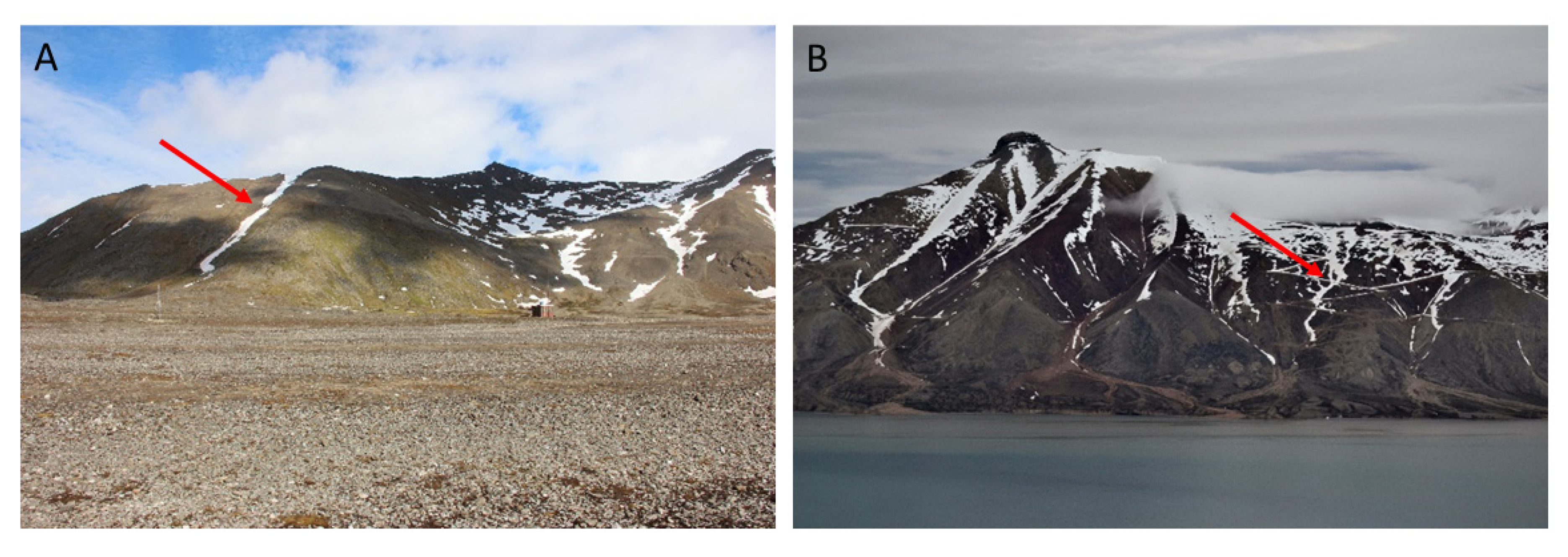
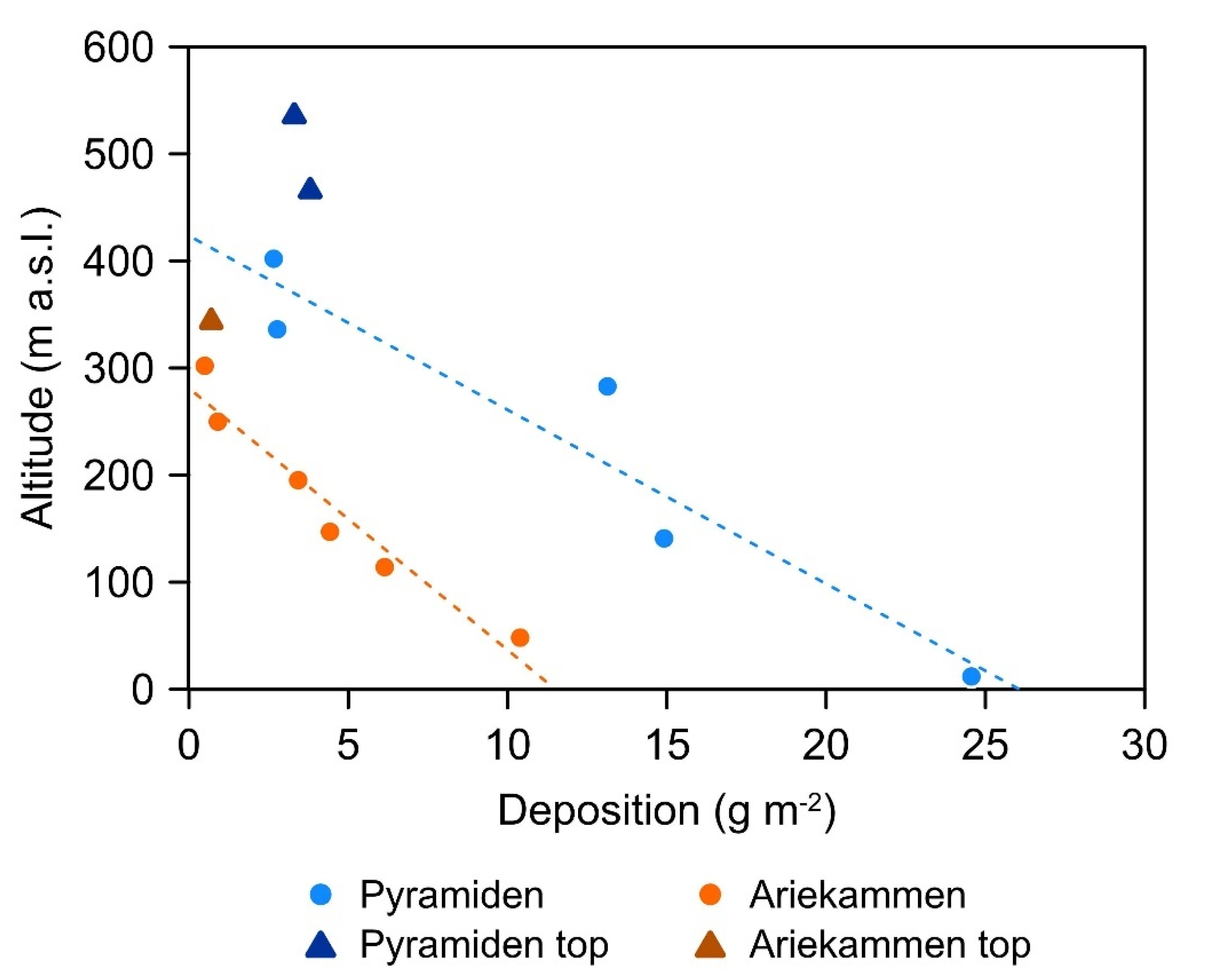
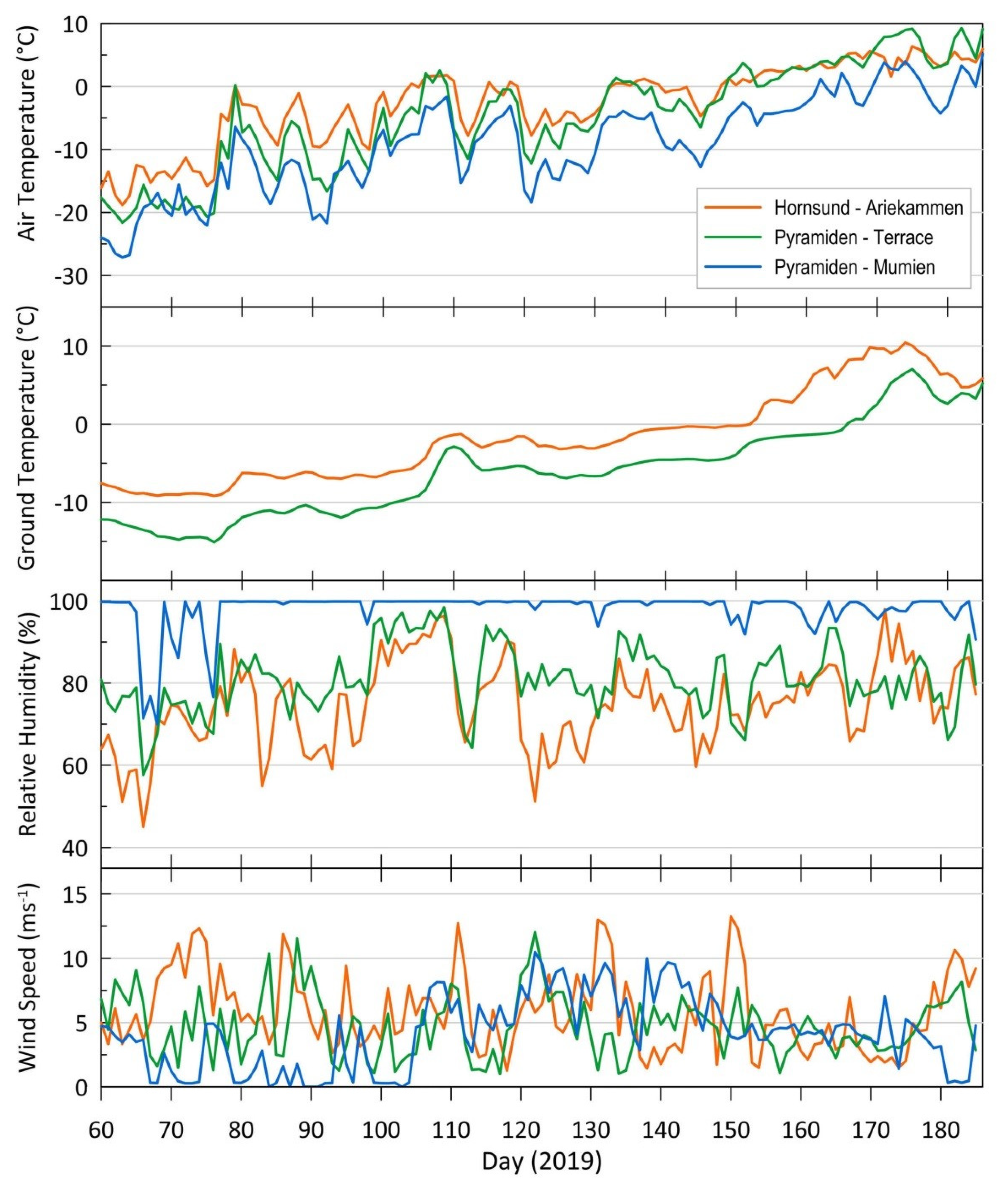


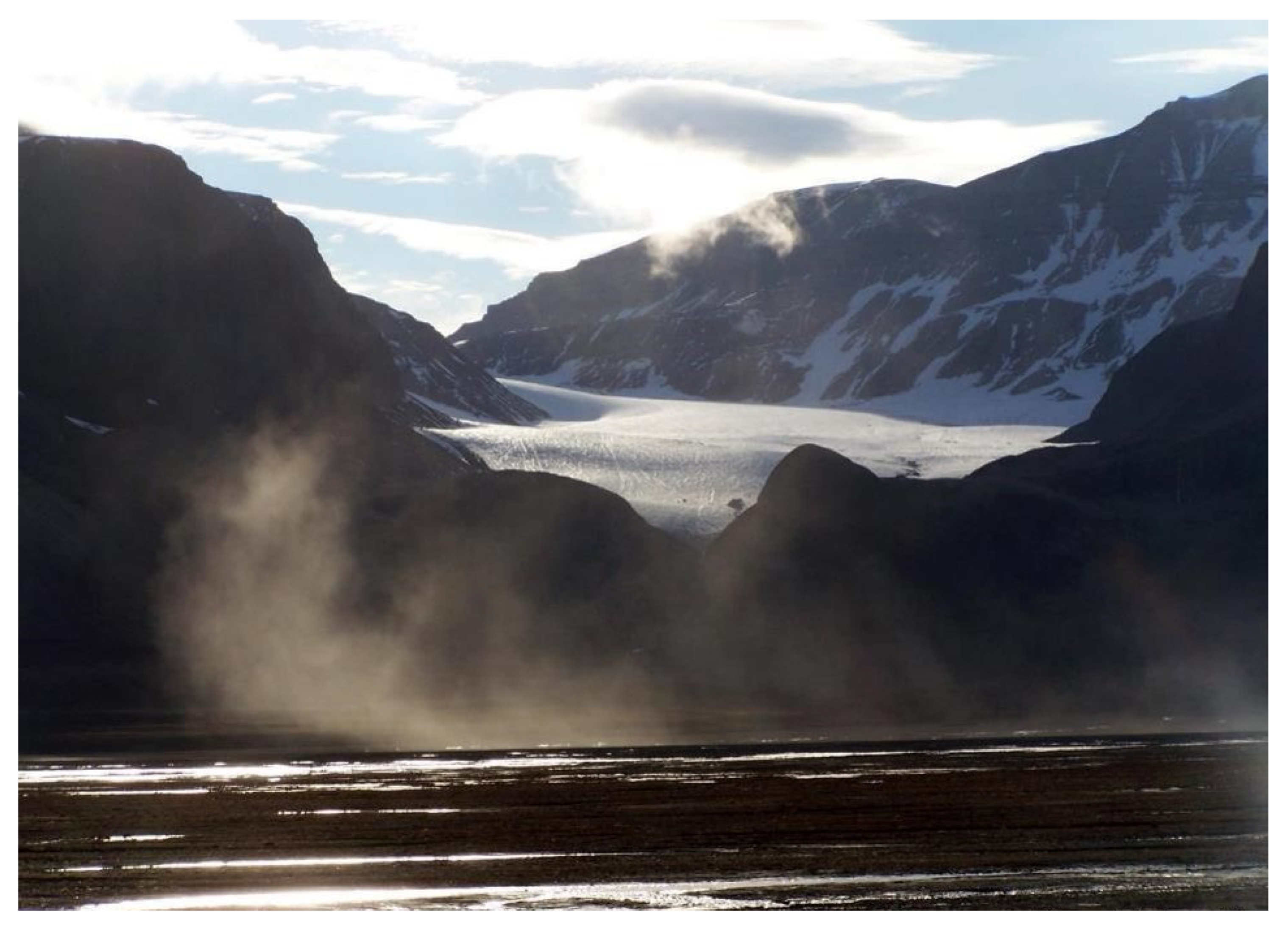
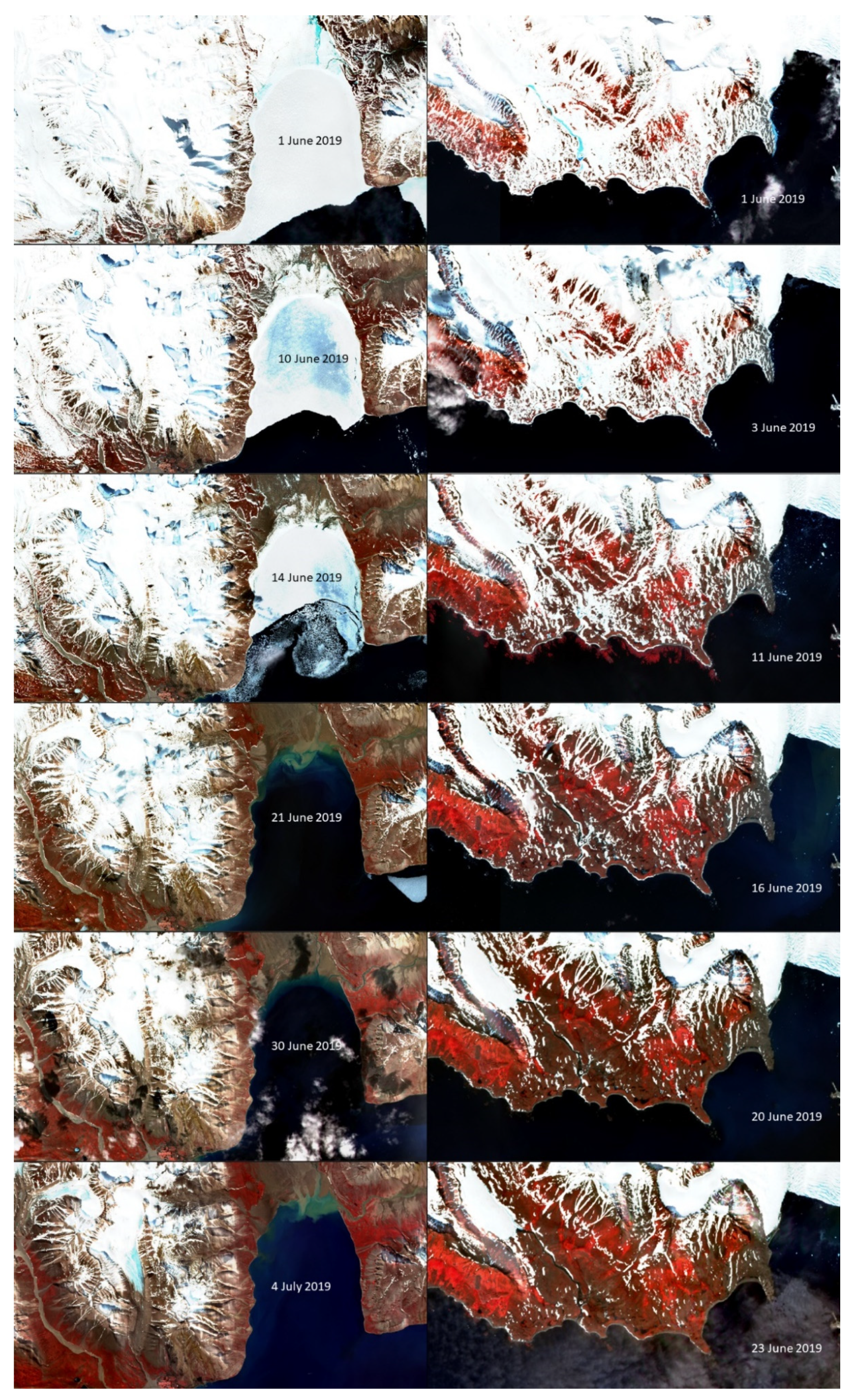
| Ariekammen | ||||||
|---|---|---|---|---|---|---|
| date | 26 June 2019 | |||||
| Sample ID | latitude | longitude | altitude (m a.s.l.) | snow density (g cm−3) | melted water volume (l) | sediment concentration (g m−2) * |
| Arie 1 | 77° 00.815′ | 15° 30.984′ | 346 | 0.49 | 0.75 | 0.70 |
| Arie 2 | 77° 00.757′ | 15° 31.001′ | 302 | 0.44 | 0.67 | 0.49 |
| Arie 3 | 77° 00.710′ | 15° 31.140′ | 250 | 0.49 | 0.76 | 0.91 |
| Arie 4 | 77° 00.667′ | 15° 31.247′ | 195 | 0.53 | 0.81 | 3.42 |
| Arie 5 | 77° 00.632′ | 15° 31.274′ | 147 | 0.54 | 0.83 | 4.43 |
| Arie 6 | 77° 00.600′ | 15° 31.319′ | 114 | 0.58 | 0.89 | 6.14 |
| Arie 7 | 77° 00.508′ | 15° 31.519′ | 48 | 0.59 | 0.91 | 10.39 |
| Pyramiden | ||||||
| date | 4 July 2019 | |||||
| Sample ID | latitude | longitude | altitude (m a.s.l.) | snow density (g cm−3) | melted water volume (l) | sediment concentration (g m−2) * |
| Pyr 1 | 78° 41.101′ | 16° 22.989′ | 538 | 0.53 | 0.82 | 3.30 |
| Pyr 2 | 78° 41.077′ | 16° 23.462′ | 468 | 0.53 | 0.82 | 3.81 |
| Pyr 3 | 78° 41.051′ | 16° 23.820′ | 402 | 0.50 | 0.77 | 2.66 |
| Pyr 4 | 78° 41.015′ | 16° 24.170′ | 336 | 0.57 | 0.87 | 2.77 |
| Pyr 5 | 78° 40.989′ | 16° 24.481′ | 283 | 0.53 | 0.81 | 13.14 |
| Pyr 6 | 78° 40.934′ | 16° 25.405′ | 141 | 0.45 | 0.70 | 14.92 |
| Pyr 7 | 78° 41.074′ | 16° 27.145′ | 12 | 0.54 | 0.83 | 24.56 |
| Hornsund | ||
|---|---|---|
| location | N 77.00035° E 15.53674° | |
| altitude | 10 m a.s.l. | |
| variable | sensor | height/depth |
| air temperature | HMP155 | 2 m a.g.l. |
| ground temperature | PT100/8 | −0.2 m |
| relative humidity | HMP155 | 2 m a.g.l. |
| wind speed | Vaisala WMT702 | 10 m a.g.l. |
| wind direction | Vaisala WMT702 | 10 m a.g.l. |
| cloud base height | manual observation | |
| Pyramiden-terrace station | ||
| location | N 78.71060° E 16.46059° | |
| altitude | 14 m a.s.l. | |
| variable | sensor | height/depth |
| air temperature | EMS33H | 2 m a.g.l. |
| ground temperature | PT100/8 | −0.2 m |
| relative humidity | EMS33H | 2 m a.g.l. |
| wind speed | MetOne 034B | 6 m a.g.l. |
| wind direction | MetOne 034B | 6 m a.g.l. |
| Pyramiden-Mumien station | ||
| location | N 78.70021° E 16.31638° | |
| altitude | 764 m a.s.l. | |
| variable | sensor | height/depth |
| air temperature | EMS33H | 2 m a.g.l. |
| ground temperature | ||
| relative humidity | EMS33H | 2 m a.g.l. |
| wind speed | MetOne 034B | 3 m a.g.l. |
| wind direction | MetOne 034B | 3 m a.g.l. |
| Sample ID. | Altitude | Si | Ca | Fe | Sr | Zr | Cl | Si/Cl |
|---|---|---|---|---|---|---|---|---|
| Arie 1 | 346 | 35,527.45 | 17,535.63 | 5591.19 | 11.46 | 13.40 | 87,185.83 | 0.41 |
| Arie 2 | 302 | 25,206.99 | 14,504.48 | 1524.64 | 7.99 | 10.48 | 120,173.77 | 0.21 |
| Arie 3 | 250 | 31,735.19 | 16,000.67 | 3347.44 | 7.49 | 13.33 | 109,335.93 | 0.29 |
| Arie 4 | 195 | 40,261.13 | 18,762.51 | 6818.82 | 17.02 | 12.53 | 75,324.28 | 0.53 |
| Arie 5 | 147 | 27,658.96 | 15,577.55 | 140.73 | 5.94 | 9.66 | 120,469.78 | 0.23 |
| Arie 6 | 114 | 43,909.46 | 16,342.59 | 1084.03 | 6.74 | 10.28 | 112,958.65 | 0.39 |
| Arie 7 | 48 | 33,987.21 | 17,620.37 | 5719.63 | 11.21 | 14.11 | 123,931.74 | 0.27 |
| sample ID | altitude | Si | Ca | Fe | Sr | Zr | Cl | Si/Cl |
| Pyr 1 | 538 | 83,923.06 | 44,008.52 | 15,012.82 | 14.38 | 25.16 | 65,231.74 | 1.29 |
| Pyr 2 | 468 | 131,277.49 | 49,174.46 | 25,515.10 | 21.63 | 40.22 | 33,653.26 | 3.90 |
| Pyr 3 | 402 | 118,449.13 | 38,302.62 | 22,119.44 | 20.97 | 47.92 | 47,749.67 | 2.48 |
| Pyr 4 | 336 | 76,141.49 | 39,493.15 | 13,722.49 | 15.83 | 28.83 | 70,748.88 | 1.08 |
| Pyr 5 | 283 | 120,432.14 | 54,083.85 | 21,212.57 | 17.36 | 51.43 | 35,132.70 | 3.43 |
| Pyr 6 | 141 | 92,032.48 | 117,957.89 | 43,413.83 | 61.53 | 168.94 | ||
| Pyr 7 | 12 | 62,264.92 | 78,181.74 | 36,727.99 | 68.53 | 158.69 | 8103.41 | 7.68 |
Publisher’s Note: MDPI stays neutral with regard to jurisdictional claims in published maps and institutional affiliations. |
© 2020 by the authors. Licensee MDPI, Basel, Switzerland. This article is an open access article distributed under the terms and conditions of the Creative Commons Attribution (CC BY) license (http://creativecommons.org/licenses/by/4.0/).
Share and Cite
Kavan, J.; Láska, K.; Nawrot, A.; Wawrzyniak, T. High Latitude Dust Transport Altitude Pattern Revealed from Deposition on Snow, Svalbard. Atmosphere 2020, 11, 1318. https://doi.org/10.3390/atmos11121318
Kavan J, Láska K, Nawrot A, Wawrzyniak T. High Latitude Dust Transport Altitude Pattern Revealed from Deposition on Snow, Svalbard. Atmosphere. 2020; 11(12):1318. https://doi.org/10.3390/atmos11121318
Chicago/Turabian StyleKavan, Jan, Kamil Láska, Adam Nawrot, and Tomasz Wawrzyniak. 2020. "High Latitude Dust Transport Altitude Pattern Revealed from Deposition on Snow, Svalbard" Atmosphere 11, no. 12: 1318. https://doi.org/10.3390/atmos11121318






